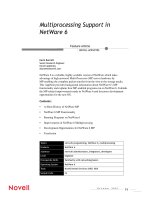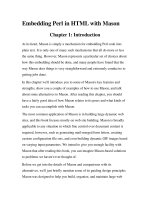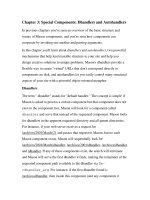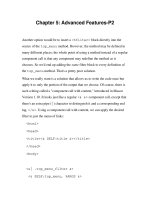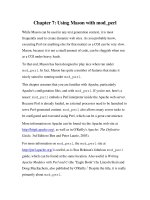Tài liệu Using ActionScript in Flash-P4 pdf
Bạn đang xem bản rút gọn của tài liệu. Xem và tải ngay bản đầy đủ của tài liệu tại đây (330.73 KB, 44 trang )
Preloading external media 301
Preloading SWF and JPEG files
To preload SWF and JPEG files into movie clip instances, you can use the “MovieClipLoader
class”. This class provides an event listener mechanism to give notification about the status of file
downloads into movie clips. Using a MovieClipLoader object to preload SWF and JPEG files
involves the following steps:
Create a new MovieClipLoader object
You can use a single MovieClipLoader object to track
the download progress of multiple files, or create a separate object for each file’s progress. Create a
new movie clip, load your contents into it, and then create the MovieClipLoader object.
this.createEmptyMovieClip("target_mc", 999);
var loader:MovieClipLoader = new MovieClipLoader();
Create a listener object and create event handlers
The listener object can be any
ActionScript object, such as a generic Object object, a movie clip, or a custom component.
For example, the following code creates a generic listener object named
loadListener
and
defines for itself
onLoadStart
,
onLoadProgress
, and
onLoadComplete
functions:
var loader:MovieClipLoader = new MovieClipLoader();
// Create listener object:
var loadListener:Object = new Object();
loadListener.onLoadStart = function(loadTarget) {
trace("Loading into "+loadTarget+" has started.");
};
loadListener.onLoadProgress = function(loadTarget, bytesLoaded, bytesTotal) {
var percentLoaded = bytesLoaded/bytesTotal*100;
trace("%"+percentLoaded+" into target "+loadTarget);
};
loadListener.onLoadComplete = function(loadTarget) {
trace("Load completed into: "+loadTarget);
};
Register the listener object with the MovieClipLoader object
In order for the listener object
to receive the loading events, you must register it with the MovieClipLoader object, as shown in
the following code:
loader.addListener(loadListener);
Begin loading the file (JPEG or SWF) into a target clip
To start the download of the JPEG or
SWF file, you use the
MovieClipLoader.loadClip()
method, as shown in the following code:
loader.loadClip("mymovie.swf", target_mc);
Note: You can use MovieClipLoader methods only to track the download progress of files loaded
with the
MovieClipLoader.loadClip()
method. You cannot use the
loadMovie()
function or
MovieClip.loadMovie()
method.
The following example uses the
setProgress()
method of the ProgressBar component to
display the download progress of a SWF file. (See “ProgressBar component” in Using
Components.)
302 Chapter 12: Working with External Media
To display download progress using the ProgressBar component:
1.
In a new Flash document, create a movie clip on the Stage and give it an instance name
target_mc
.
2.
Open the Components panel (Window > Development Panels > Components).
3.
Drag a ProgressBar component from the Components panel to the Stage.
4.
In the Property inspector, give the ProgressBar component the name
pBar
and, on the
Parameters tab, select Manual from the Mode pop-up menu.
5.
Select Frame 1 in the Timeline, and open the Actions panel (Window > Development Panels >
Actions).
6.
Add the following code to the Actions panel:
// create both a MovieClipLoader object and a listener object
myLoader = new MovieClipLoader();
myListener = new Object();
// add the MovieClipLoader callbacks to your listener object
myListener.onLoadStart = function(clip) {
// this event is triggered once, when the load starts
pBar.label = "Now loading: " + clip;
};
myListener.onLoadProgress = function(clip, bytesLoaded, bytesTotal) {
var percentLoaded = int (100*(bytesLoaded/bytesTotal));
pBar.setProgress(bytesLoaded, bytesTotal);
};
myLoader.addListener(myListener);
myLoader.loadClip("veryLargeFile.swf", target_mc);
7.
Test the document by selecting Control > Test Movie. You can see the movie load.
8.
Publish to HTML, and open the HTML file in a browser to see the progress bar in action.
For more information, see “MovieClipLoader class” in Flash ActionScript Language Reference.
Preloading MP3 and FLV files
To preload MP3 and FLV files, you can use the
setInterval()
function to create a polling
mechanism that checks the bytes loaded for a Sound or NetStream object at predetermined
intervals. To track the download progress of MP3 files, use the
Sound.getBytesLoaded()
and
Sound.getBytesTotal()
methods; to track the download progress of FLV files, use the
NetStream.bytesLoaded
and
NetStream.bytesTotal
properties.
The following code uses
setInterval()
to check the bytes loaded for a Sound or NetStream
object at predetermined intervals:
// Create a new Sound object to play the sound.
var songTrack:Sound = new Sound();
// Create the polling function that tracks download progress.
// This is the function that is "polled." It checks
// the download progress of the Sound object passed as a reference.
checkProgress = function (soundObj) {
var bytesLoaded = soundObj.getBytesLoaded();
var bytesTotal = soundObj.getBytesTotal();
var percentLoaded = Math.floor(bytesLoaded/bytesTotal * 100);
Preloading external media 303
trace("%" + percentLoaded + " loaded.");
};
// When the file has finished loading, clear the interval polling.
songTrack.onLoad = function () {
clearInterval(poll);
};
// Load streaming MP3 file and start calling checkProgress()
songTrack.loadSound(" true);
var poll = setInterval(checkProgress, 1000, songTrack);
You can use this same kind of polling technique to preload external FLV files. To get the total
bytes and current number of bytes loaded for an FLV file, use the
NetStream.bytesLoaded
and
NetStream.bytesTotal
properties. Try loading your song from a server to see the loading
progress in the Output panel.
Another way to preload FLV files is to use the
NetStream.setBufferTime()
method. This
method takes a single parameter that indicates the number of seconds of the FLV stream to
download before playback begins.
For more information, see
MovieClip.getBytesLoaded()
,
MovieClip.getBytesTotal()
,
NetStream.bytesLoaded
,
NetStream.bytesTotal
,
NetStream.setBufferTime()
,
setInterval()
,
Sound.getBytesLoaded()
, and
Sound.getBytesTotal()
in Flash ActionScript
Language Reference.
304 Chapter 12: Working with External Media
305
APPENDIX A
Error Messages
Macromedia Flash MX 2004 and Macromedia Flash MX Professional 2004 provide enhanced
compile-time error reporting when you publish to ActionScript 2.0 (the default). The following
table contains a list of error messages that the Flash compiler can generate:
Error number Message text
1093 A class name was expected.
1094 A base class name is expected after the ‘extends’ keyword.
1095 A member attribute was used incorrectly.
1096 The same member name may not be repeated more than once.
1097 All member functions need to have names.
1099 This statement is not permitted in a class definition.
1100 A class or interface has already been defined with this name.
1101 Type mismatch.
1102 There is no class with the name ‘<ClassName>’.
1103 There is no property with the name ‘<propertyName>’.
1104 A function call on a non-function was attempted.
1105 Type mismatch in assignment statement: found [lhs-type] where [rhs-type]
is required.
1106 The member is private and cannot be accessed.
1107 Variable declarations are not permitted in interfaces.
1108 Event declarations are not permitted in interfaces.
1109 Getter/setter declarations are not permitted in interfaces.
1110 Private members are not permitted in interfaces.
1111 Function bodies are not permitted in interfaces.
1112 A class may not extend itself.
1113 An interface may not extend itself.
306 Appendix A: Error Messages
1114 There is no interface defined with this name.
1115 A class may not extend an interface.
1116 An interface may not extend a class.
1117 An interface name is expected after the ‘implements’ keyword.
1118 A class may not implement a class, only interfaces.
1119 The class must implement method ‘methodName’ from interface ‘interfaceName’.
1120 The implementation of an interface method must be a method, not a property.
1121 A class may not extend the same interface more than once.
1122 The implementation of the interface method doesn’t match its definition.
1123 This construct is only available in ActionScript 1.
1124 This construct is only available in ActionScript 2.0.
1125 Static members are not permitted in interfaces.
1126 The expression returned must match the function’s return type.
1127 A return statement is required in this function.
1128 Attribute used outside class.
1129 A function with return type Void may not return a value.
1130 The ‘extends’ clause must appear before the ‘implements’ clause.
1131 A type identifier is expected after the ‘:’.
1132 Interfaces must use the ‘extends’ keyword, not ‘implements’.
1133 A class may not extend more than one class.
1134 An interface may not extend more than one interface.
1135 There is no method with the name ‘<methodName>’.
1136 This statement is not permitted in an interface definition.
1137 A set function requires exactly one parameter.
1138 A get function requires no parameters.
1139 Classes may only be defined in external ActionScript 2.0 class scripts.
1140 ActionScript 2.0 class scripts may only define class or interface constructs.
1141 The name of this class, ‘<A.B.C>’, conflicts with the name of another class that was
loaded, ‘<A.B>’.
(This error occurs when the ActionScript 2.0 compiler cannot compile a class
because of the full name of an existing class is part of the conflicting class' name.
For example, compiling class
mx.com.util
generates error 1141 if class
mx.com
is a
compiled class.)
1142 The class ‘<ClassName>’ could not be loaded.
1143 Interfaces may only be defined in external ActionScript 2.0 class scripts.
Error number Message text
307
1144 Instance variables cannot be accessed in static functions.
1145 Class and interface definitions cannot be nested.
1146 The property being referenced does not have the static attribute.
1147 This call to super does not match the superconstructor.
1148 Only the public attribute is allowed for interface methods.
1149 The import keyword cannot be used as a directive.
1150 You must export your movie as Flash 7 to use this action.
1151 You must export your movie as Flash 7 to use this expression.
1152 This exception clause is placed improperly.
1153 A class must have only one constructor.
1154 A constructor may not return a value.
1155 A constructor may not specify a return type.
1156 A variable may not be of type Void.
1157 A function parameter may not be of type Void.
1158 Static members can only be accessed directly through classes.
1159 Multiple implemented interfaces contain same method with different types.
1160 There is already a class or interface defined with this name.
1161 Classes, interfaces, and built-in types may not be deleted.
1162 There is no class with this name.
1163 The keyword ‘<keyword>’ is reserved for ActionScript 2.0 and cannot be used here.
1164 Custom attribute definition was not terminated.
1165 Only one class or interface can be defined per ActionScript 2.0 as file.
1166 The class being compiled, ‘<A.b>’, does not match the class that was imported,
‘<A.B>’.
(This error occurs when a class name is spelled with a different case from an
imported class. For example, compiling class
mx.com.util
generates error 1166 if
the statement
import mx.Com
appears in the util.as file.)
1167 You must enter a class name.
1168 The class name you have entered contains a syntax error.
1169 The interface name you have entered contains a syntax error.
1170 The base class name you have entered contains a syntax error.
1171 The base interface name you have entered contains a syntax error.
1172 You must enter an interface name.
1173 You must enter a class or interface name.
Error number Message text
308 Appendix A: Error Messages
1174 The class or interface name you have entered contains a syntax error.
1175 ‘variable’ is not accessible from this scope.
1176 Multiple occurrences of the ‘get/set/private/public/static’ attribute were found.
1177 A class attribute was used incorrectly.
1178 Instance variables and functions may not be used to initialize static variables.
1179 Runtime circularities were discovered between the following classes: <list of user-
defined classes>.
This runtime error indicates that your custom classes are incorrectly referencing
each other.
1180 The currently targeted Flash Player does not support debugging.
1181 The currently targeted Flash Player does not support the releaseOutside event.
1182 The currently targeted Flash Player does not support the dragOver event.
1183 The currently targeted Flash Player does not support the dragOut event.
1184 The currently targeted Flash Player does not support dragging actions.
1185 The currently targeted Flash Player does not support the loadMovie action.
1186 The currently targeted Flash Player does not support the getURL action.
1187 The currently targeted Flash Player does not support the FSCommand action.
1188 Import statements are not allowed inside class or interface definitions.
1189 The class ‘<A.B>’ cannot be imported because its leaf name is already resolved to the
class that is being defined, ‘<C.B>’.
(For example, compiling class
util
generates error 1189 if the statement
import
mx.util
appears in the util.as file.)
1190 The class ‘<A.B>’ cannot be imported because its leaf name is already resolved to a
previously imported class ‘<C.B>’.
(For example, compiling
import jv.util
generates error 1190 if the statement
import mx.util
also appears in the AS file.)
1191 A class’ instance variables may only be initialized to compile-time
constant expressions.
1192 Class member functions cannot have the same name as a superclass’
constructor function.
1193 The name of this class, ‘<ClassName>’, conflicts with the name of another class that
was loaded.
1194 The superconstructor must be called first in the constructor body.
1195 The identifier ‘<className>’ will not resolve to built-in object ‘<ClassName>’
at runtime.
1196 The class ‘<A.B.ClassName>’ needs to be defined in a file whose relative path is
<‘A.B>’.
1197 The wildcard character ‘*’ is misused in the ClassName ‘<ClassName>’.
Error number Message text
309
1198 The member function ‘<classname>’ has a different case from the name of the class
being defined, ‘<ClassName>’, and will not be treated as the class constructor
at runtime.
1199 The only type allowed for a for-in loop iterator is String.
1200 A setter function may not return a value.
1201 The only attributes allowed for constructor functions are public and private.
Error number Message text
310 Appendix A: Error Messages
311
APPENDIX B
Deprecated Flash 4 operators
The following table lists Flash 4-only operators, which are deprecated in ActionScript 2.0. Do not
use these operators unless you are publishing to Flash Player 4 and earlier.
Operator Description Associativity
not
Logical NOT Right to left
and
Logical AND Left to right
or
Logical OR (Flash 4) Left to right
add
String concatenation (formerly &) Left to right
instanceof
Instance of Left to right
lt
Less than (string version) Left to right
le
Less than or equal to (string version) Left to right
gt
Greater than (string version) Left to right
ge
Greater than or equal to (string version) Left to right
eq
Equal (string version) Left to right
ne
Not equal (string version) Left to right
312 Appendix B: Deprecated Flash 4 operators
313
APPENDIX C
Keyboard Keys and Key Code Values
The following tables list all the keys on a standard keyboard and the corresponding ASCII key
code values that are used to identify the keys in ActionScript:
•
“Letters A to Z and standard numbers 0 to 9”
•
“Keys on the numeric keypad” on page 314
•
“Function keys” on page 315
•
“Other keys” on page 316
Letters A to Z and standard numbers 0 to 9
The following table lists the keys on a standard keyboard for the letters A to Z and the numbers
0 to 9, with the corresponding ASCII key code values that are used to identify the keys
in ActionScript:
Letter or number key Key code
A65
B66
C67
D68
E69
F70
G71
H72
I73
J74
K75
L76
M77
314 Appendix C: Keyboard Keys and Key Code Values
Keys on the numeric keypad
The following table lists the keys on a numeric keypad, with the corresponding ASCII key code
values that are used to identify the keys in ActionScript:
N78
O79
P80
Q81
R82
S83
T84
U85
V86
W87
X88
Y89
Z90
048
149
250
351
452
553
654
755
856
957
Numeric keypad key Key code
Numbpad 0 96
Numbpad 1 97
Numbpad 2 98
Numbpad 3 99
Numbpad 4 100
Letter or number key Key code
Function keys 315
Function keys
The following table lists the function keys on a standard keyboard, with the corresponding ASCII
key code values that are used to identify the keys in ActionScript:
Numbpad 5 101
Numbpad 6 102
Numbpad 7 103
Numbpad 8 104
Numbpad 9 105
Multiply 106
Add 107
Enter 13
Subtract 109
Decimal 110
Divide 111
Function key Key code
F1 112
F2 113
F3 114
F4 115
F5 116
F6 117
F7 118
F8 119
F9 120
F10 This key is reserved by the system and cannot be used in ActionScript.
F11 122
F12 123
F13 124
F14 125
F15 126
Numeric keypad key Key code
316 Appendix C: Keyboard Keys and Key Code Values
Other keys
The following table lists keys on a standard keyboard other than letters, numbers, numeric
keypad keys, or function keys, with the corresponding ASCII key code values that are used to
identify the keys in ActionScript:
Key Key code
Backspace 8
Tab 9
Clear 12
Enter 13
Shift 16
Control 17
Alt 18
Caps Lock 20
Esc 27
Spacebar 32
Page Up 33
Page Down 34
End 35
Home 36
Left Arrow 37
Up Arrow 38
Right Arrow 39
Down Arrow 40
Insert 45
Delete 46
Help 47
Num Lock 144
; : 186
= + 187
- _ 189
/ ? 191
` ~ 192
[ { 219
\ | 220
Other keys 317
] } 221
" ' 222
Key Key code


